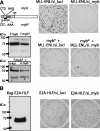c-Myb is an essential downstream target for homeobox-mediated transformation of hematopoietic cells
- PMID: 16507773
- PMCID: PMC1895838
- DOI: 10.1182/blood-2005-12-5014
c-Myb is an essential downstream target for homeobox-mediated transformation of hematopoietic cells
Abstract
Abdominal-type HoxA genes in combination with Meis1 are well-documented on-cogenes in various leukemias but it is unclear how they exert their transforming function. Here we used a system of conditional transformation by an inducible mixed lineage leukemia-eleven-nineteen leukemia (MLL-ENL) oncoprotein to overexpress Hoxa9 and Meis1 in primary hematopoietic cells. Arrays identified c-Myb and a c-Myb target (Gstm1) among the genes with the strongest response to Hoxa9/Meis1. c-Myb overexpression was verified by Northern blot and quantitative reverse transcription-polymerase chain reaction (RT-PCR). Also MLL-ENL activated c-Myb through up-regulation of Hoxa9 and Meis1. Consequently, short-term suppression of c-Myb by small inhibitory RNA (siRNA) efficiently inhibited transformation by MLL-ENL but did not impair transformation by transcription factor E2A-hepatic leukemia factor (E2A-HLF). The anti c-Myb siRNA effect was abrogated by coexpression of a c-Myb derivative with a mutated siRNA target site. The introduction of a dominant-negative c-Myb mutant had a similar but weaker effect on MLL-ENL-mediated transformation. Hematopoietic precursors from mice homozygous for a hypo-morphic c-Myb allele were more severely affected and could be transformed neither by MLL-ENL nor by E2A-HLF. Ectopic expression of c-Myb induced a differentiation block but c-Myb alone was not transforming in a replating assay similar to Hoxa9/Meis1. These results suggest that c-Myb is essential but not sufficient for Hoxa9/Meis1 mediated transformation.
Figures






Similar articles
-
PBX3 and MEIS1 Cooperate in Hematopoietic Cells to Drive Acute Myeloid Leukemias Characterized by a Core Transcriptome of the MLL-Rearranged Disease.Cancer Res. 2016 Feb 1;76(3):619-29. doi: 10.1158/0008-5472.CAN-15-1566. Epub 2016 Jan 8. Cancer Res. 2016. PMID: 26747896 Free PMC article.
-
Hoxa9 and Meis1 are key targets for MLL-ENL-mediated cellular immortalization.Mol Cell Biol. 2004 Jan;24(2):617-28. doi: 10.1128/MCB.24.2.617-628.2004. Mol Cell Biol. 2004. PMID: 14701735 Free PMC article.
-
Flt3 is dispensable to the Hoxa9/Meis1 leukemogenic cooperation.Blood. 2007 May 1;109(9):4020-2. doi: 10.1182/blood-2006-01-039586. Epub 2007 Jan 3. Blood. 2007. PMID: 17202314
-
Deregulation of the HOXA9/MEIS1 axis in acute leukemia.Curr Opin Hematol. 2016 Jul;23(4):354-61. doi: 10.1097/MOH.0000000000000245. Curr Opin Hematol. 2016. PMID: 27258906 Free PMC article. Review.
-
The Historical Relationship Between Meis1 and Leukemia.Adv Exp Med Biol. 2022;1387:127-144. doi: 10.1007/5584_2021_705. Adv Exp Med Biol. 2022. PMID: 35304708 Review.
Cited by
-
Histone-modifying enzymes: their role in the pathogenesis of acute leukemia and their therapeutic potential.Int J Hematol. 2013 Feb;97(2):198-209. doi: 10.1007/s12185-012-1247-y. Epub 2013 Jan 4. Int J Hematol. 2013. PMID: 23288492 Free PMC article. Review.
-
The histone acetyltransferase TIP60 interacts with c-Myb and inactivates its transcriptional activity in human leukemia.J Biol Chem. 2012 Jan 6;287(2):925-34. doi: 10.1074/jbc.M111.279950. Epub 2011 Nov 21. J Biol Chem. 2012. PMID: 22110127 Free PMC article.
-
C/EBPβ cooperates with MYB to maintain the oncogenic program of AML cells.Oncotarget. 2023 Mar 11;14:174-177. doi: 10.18632/oncotarget.28377. Oncotarget. 2023. PMID: 36913305 Free PMC article.
-
Direct and Indirect Targeting of HOXA9 Transcription Factor in Acute Myeloid Leukemia.Cancers (Basel). 2019 Jun 17;11(6):837. doi: 10.3390/cancers11060837. Cancers (Basel). 2019. PMID: 31213012 Free PMC article. Review.
-
Molecular and Epigenetic Mechanisms of MLL in Human Leukemogenesis.Cancers (Basel). 2012 Sep 10;4(3):904-44. doi: 10.3390/cancers4030904. Cancers (Basel). 2012. PMID: 24213472 Free PMC article.
References
-
- Abramovich C, Humphries RK. Hox regulation of normal and leukemic hematopoietic stem cells. Curr Opin Hematol. 2005;12: 210-216. - PubMed
-
- Abramovich C, Pineault N, Ohta H, Humphries RK. Hox genes: from leukemia to hematopoietic stem cell expansion. Ann N Y Acad Sci. 2005;1044: 109-116. - PubMed
-
- Pineault N, Helgason CD, Lawrence HJ, Humphries RK. Differential expression of Hox, Meis1, and Pbx1 genes in primitive cells throughout murine hematopoietic ontogeny. Exp Hematol. 2002;30: 49-57. - PubMed
Publication types
MeSH terms
Substances
Grants and funding
LinkOut - more resources
Full Text Sources
Other Literature Sources
Medical
Research Materials
Miscellaneous

